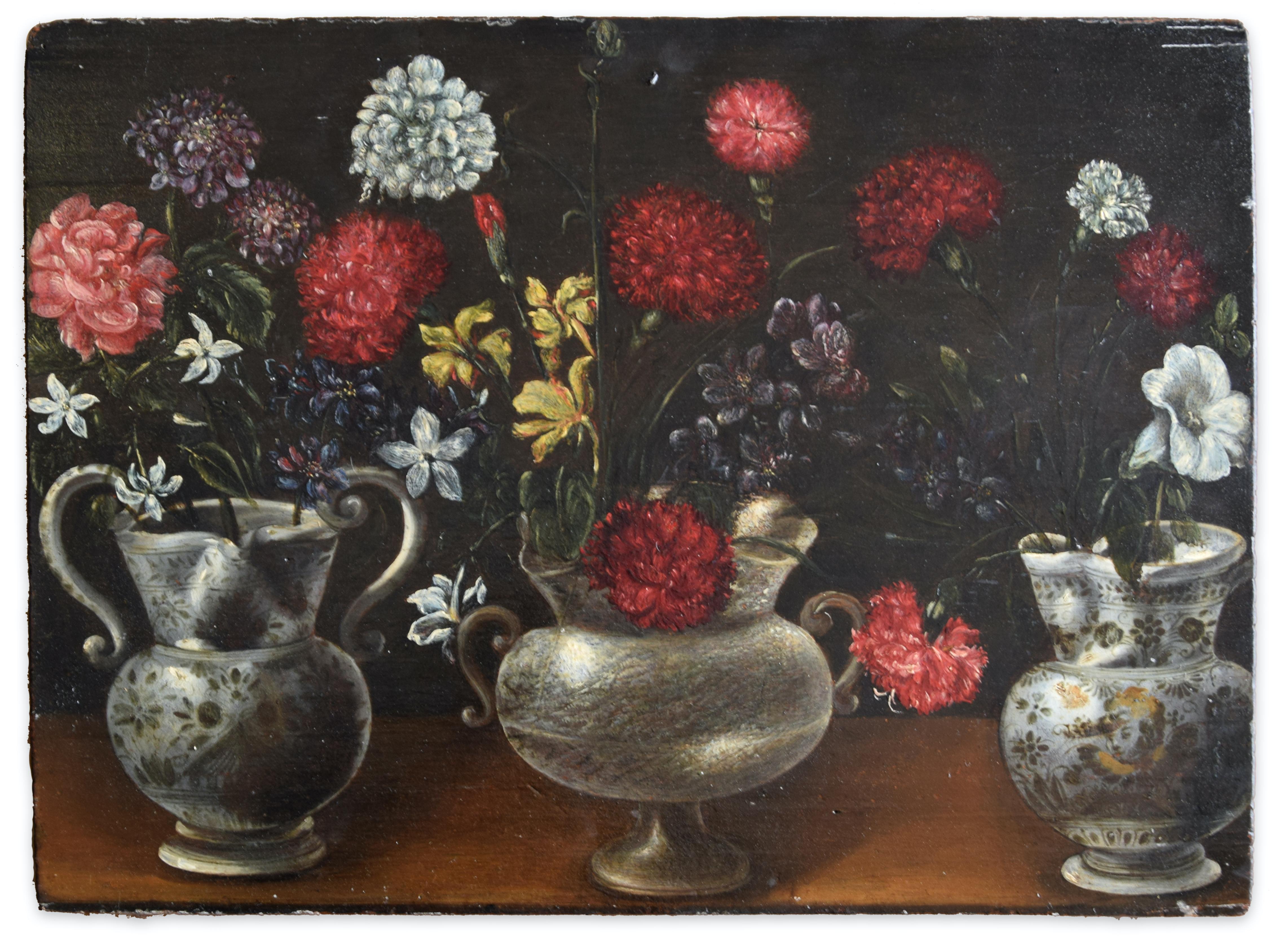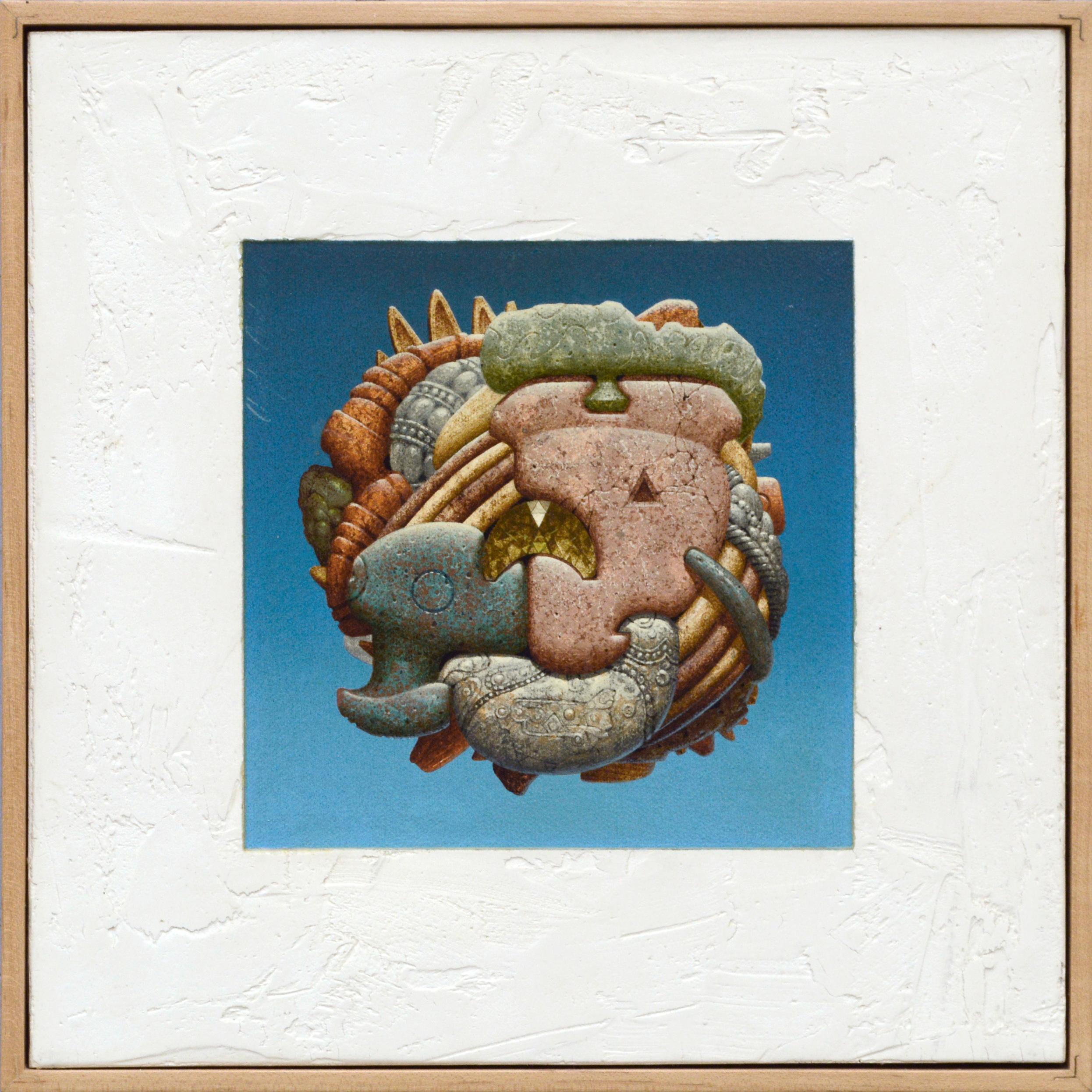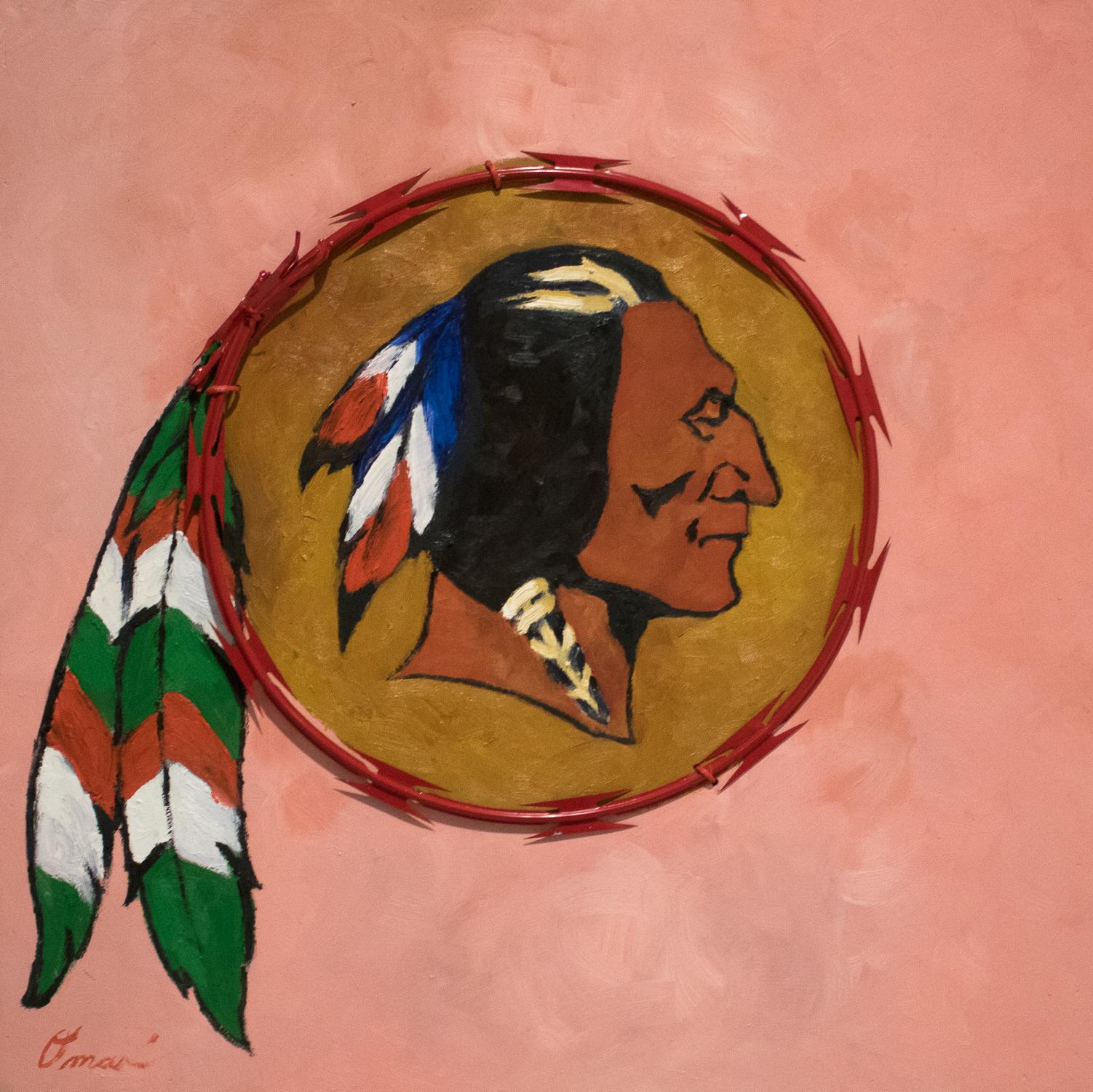Items Similar to Prometheus
Want more images or videos?
Request additional images or videos from the seller
1 of 6
Maxfield ParrishPrometheus1919
1919
About the Item
Medium: Oil on Panel
Sight Size 31.00" x 21.25", Framed 36.00" x 22.00"
Signature: Signed Lower Left
Maxfield Parrish began his career at age 25 as an illustrator, painting magazine covers, advertisements, posters and book illustrations. He was already a well-respected commercial artist when, in 1917, he received a commission from General Electric to produce annual calendar illustrations to advertise the company’s Electric-Edison Mazda Lamps. Eager to sell their product as new and innovative, GE executives asked the artist to emphasize the many facets of light: natural, manmade and fantastical. Over the course of the next 15 years, Parrish created a group of 17 paintings illustrating the progression of the history of light, the immense popularity of which transformed the artist into a national icon. Between 1917 and 1931, over 20 million copies of the calendar were painstakingly reproduced in two different sizes and four different colors. Parrish enjoyed painting images for calendars, because he loved the immediacy and ubiquity of these commissions: far more people would gain exposure to his work in the offices, banks and stores where the calendars commonly hung. If the artist was not already well-known in popular culture through his illustrations and other ads, Parrish became a household name through the Mazda commission.
Prometheus, painted in 1919 and published the following year, visually translates a mythical tale of Prometheus, the Titan who stole fire from the Olympian gods and presented it to early man, thus allowing for the evolution of civilization and cultural progress. As a result of this act, Prometheus became the patron of all earthly artists and thinkers as he brought enlightenment to the world. Parrish emphasizes this heroic interpretation in the present work by depicting the subject in clear mythological glory. Bathed in a warm golden light, Prometheus is rendered in the classical Greek style, idealized and youthful, returning triumphantly to earth bearing the flame of the gods. Although the scene’s iconography is predominantly appropriated ancient Greek sources, Prometheus characteristically incorporates such diverse influences as Old Master principles, Pre-Raphaelite aesthetics, and Parrish’s own vivid imagination to achieve a fantastical scene that both appealed to popular imagination and was perfectly suited to the corporate image GE wanted to project.
The preternatural landscape rendered behind the figure was likely conjured by Parrish’s fertile imagination; he created these make-believe “Parrishscapes” by synthesizing both real and imagined natural elements. Behind the protagonist, a distant view reveals a mysterious mountainous landscape. The artist’s dazzling gifts as a colorist reveal themselves as the dramatic moonlight beams down upon the crystal calm lake and the craggy outcroppings that surround it. The velvety, midnight blue was reportedly inspired by the effects of light filtering through the cloud layer that Parrish felt was specific to New England: “There is an intense blue in New England,” he once wrote. “Put a mountain here, against the east, in a clear sunset glow, and it would be more startling than in Arizona” (quoted in Alma Gilbert, The Masterworks, Berkeley, California, 1992, p. 103). The present work exhibits a remarkable luminosity and purity of colors that Parrish attained by painting with layers of transparent colored glazes, now considered a hallmark of his distinctive style. Displaying lush color effects and an extraordinary attention to detail, Prometheus impressively demonstrates the unique style and vivid imagination that has earned Parrish his place among the most celebrated and beloved of American illustrators.
Exhibited
Chadds Ford, Pennsylvania, Brandywine River Museum, Maxfield Parrish, Master of Make-Believe: An Exhibition, June-September 1974, no. 58
San Mateo, California, La Galeria, Maxfield Parrish, 1976
Windsor, Vermont, The Oaks: Maxfield Parrish Museum, June-August 1978
Currently Being Exhibited At: Brandywine River Museum, A Date with Art: The Business of Illustrated Calendars, January 25, 2014- May 18, 2014
Literature
Coy Ludwig, Maxfield Parrish, New York, 1973, pp. 126, 137, pl. 37, illustrated in color
Paul W. Skeeters, Maxfield Parrish: The Early Years, 1893-1930, Secaucus, New Jersey, 1973, p. 71, illustrated in color
Laurence S. Cutler, Judy Goffman and The American Illustrators Gallery,Maxfield Parrish, London, 1993, p. 69, illustrated in color p. 68
Alma Gilbert, Maxfield Parrish: The Masterworks, Berkeley, California, 1995, fig. 5.4, pp. 96, 97, 113, illustrated in color p. 101
Laurence S. Cutler, Judy Goffman Cutler and the National Museum of American Illustration, Maxfield Parrish and the American Imagists, Edison, New Jersey, 2004, p. 269, illustrated in color
- Creator:Maxfield Parrish (1870-1966, American)
- Creation Year:1919
- Dimensions:Height: 31 in (78.74 cm)Width: 21.25 in (53.98 cm)
- Medium:
- Period:
- Condition:
- Gallery Location:Fort Washington, PA
- Reference Number:1stDibs: LU38431688453
About the Seller
5.0
Recognized Seller
These prestigious sellers are industry leaders and represent the highest echelon for item quality and design.
Gold Seller
These expertly vetted sellers are highly rated and consistently exceed customer expectations.
Established in 1995
1stDibs seller since 2016
107 sales on 1stDibs
Typical response time: 4 hours
- ShippingRetrieving quote...Ships From: Fort Washington, PA
- Return PolicyA return for this item may be initiated within 14 days of delivery.
More From This SellerView All
- King LouisBy Howard PyleLocated in Fort Washington, PAMedium: Oil on Panel Signature: Signed "H. Pyle" Lower Right and Inscribed Indistinctly On the Reverse "At the same time he extended toward King Louis the ...Category
1890s Figurative Paintings
MaterialsPanel, Oil
- FFA Student with his FatherBy John Philip FalterLocated in Fort Washington, PAMedium: Oil on Panel Signature: Signed Lower Right An FFA student with his father receiving a check for his first delivery of steers to the Omaha stockyard.Category
20th Century Figurative Paintings
MaterialsPanel, Oil
- Couple in a Horse-Drawn CarriageBy William Henry Dethlef KoernerLocated in Fort Washington, PADate: 1923 Medium: Oil on Panel Dimensions: 24.00" x 36.00"Category
1920s Figurative Paintings
MaterialsPanel, Oil
- Four Women in a Fanciful Garden SettingBy Howard Chandler ChristyLocated in Fort Washington, PAMedium: Oil on Panel in Three Parts Dimensions: 66.25" x 71.75" Signature: Signed and Dated 'Howard Chandler Christy/1929' (the third panel, lower right)Category
Early 20th Century Figurative Paintings
MaterialsOil, Panel
- Laurel & HardyLocated in Fort Washington, PAMedium: Oil on Wood Panel Signature: Unsigned This Stan Laurel and Oliver Hardy illustration was used as a traveling show sign.Category
1940s Figurative Paintings
MaterialsOil, Wood, Panel, Wood Panel
- My Duty Towards my Neighbor, and My Duty Towards God (diptych)By Maxfield ParrishLocated in Fort Washington, PAMedium: Oil on Panel Signature:Signed & Dated Lower Right, ii: Signed & Dated Lower Left Literature: Coy Ludwig, Maxfield Parrish, New York, 1973, p. 153, nos. 194-95, illustrated...Category
1890s Figurative Paintings
MaterialsPanel, Oil
You May Also Like
- Jacob's Blessing - Oil on Canvas by Andrea Appiani Il Giovane - Mid-19th CenturyLocated in Roma, ITJacob's Blessing is an original painting realized in the mid-19th Century by the Italian artist Andrea Appiani Il Giovane (Milan, 1817 - Milan, 1865). ...Category
Mid-19th Century Figurative Paintings
MaterialsOil, Panel
- Still Life of Bouquet in two-handled vases - Oil on Panel by Vincenzo dé FioriLocated in Roma, ITStill Life is a superb original oil painting on panel, realized by the Italian artist Vincenzino Volò, best-known as Vincenzino dei Fiori (Rémondans, 1620-Milan, 1671) around 1640-1660. Original Title: Natura morta di fiori entro vasi biansati (Still life of Bouquet in two-handled vases). On the back of the panel, two labels are glued "da Milano", "A Piacenza", ("from Milan" "to Piacenza"). The labels indicate a transfer of the artwork, perhaps in the first half of the twentieth century, from Piacenza to Milan. While instead the style and technique make us understand the artwork was commissioned or created in the Milan of Federico Borromeo, archbishop of Milan from1595 to 1630. The author of the painting can be identified in the person of Vincenzo Volò, a talented artist who fell into oblivion, recently rediscovered and appreciated. Founder of the Vincenzini family, he was born in Franche-Comté in 1620 (in the past its birth was erroneously fixed to 1606). In the mid-forties of the seventeenth century he arrived to Milan, and held a leading artistic role: he was the founder of a family workshop that imposed his style and strongly influenced Milanese collecting with his still lifes and influenced generations and generations of painters. Vincenzino also was the first painter of still life to work on the Bella Island for Vitaliano VI Borromeo and collaborated with well-known figure painters such as Francesco Cairo, Scaramuccia, Nuvolone and Fumagalli. As regards the style, the archaic tendency of Lombard painting of still life from the early decades of the seventeenth century is clearly evident, looking at primitivism and the happy schematization of the composition of the artwork. The dating of this artwork could be fixed around the first half of the seventeenth century because it is confirmed by the type of support, a wooden panel, always used by Vincenzino. As for the subject, Volò generally painted bouquets of flowers in two-handled vases placed on transversal planes seen from the front. It is possible to compare this work with other Dei Fiori's artworks: the pair of Flower Vases...Category
Mid-17th Century Still-life Paintings
MaterialsWood Panel, Oil
- Il Lancio delle Raviole - Oil on Wooden Panel by C. Benghi - 2000sBy Claudio BenghiLocated in Roma, ITIl Lancio delle Raviole is a beautiful original oil painting on panel, realized by the contemporary Italian artist Claudio Benghi. Title, tecnique, dimensions and signature are hand...Category
Early 2000s Contemporary Figurative Paintings
MaterialsOil, Wood Panel
- Ballerina - Oil on Wooden Panel by C. Benghi - 2000sBy Claudio BenghiLocated in Roma, ITBallerina is a touching original oil painting on panel realized by the contemporary Italian artist Claudio Benghi. Title, tecnique, dimensions and signature are hand-written with a ...Category
Early 2000s Contemporary Figurative Paintings
MaterialsOil, Wood Panel
- Vintage Surrealist Composition - Precious Stones AbstractBy Clayton AndersonLocated in Soquel, CAHighly detailed surrealist composition evoking tribal, abstracted carved stone-like shapes fitting together like a three dimensional sphere shaped puzzle, floating in a sky blue space by Clayton Anderson (American b. 1943). Textured plaster border around the edge of the piece. Signed "Clayton Anderson" along the upper left edge and on verso. Presented in a deep maple box frame. Clayton Anderson (American, b. 1943) studied at the Pennsylvania Academy of the Fine Arts and worked with Ben Kimihira, Walter...Category
1970s Surrealist Abstract Paintings
MaterialsPlaster, Oil, Wood Panel
- REDSKIN - contemporary political painting, pink, red razor wire, native chiefBy Omari BookerLocated in Signal Mountain, TNREDSKIN is one of eight pieces in Nashville based artist Omari Booker's series for his solo show “Red Line” at Channel to Channel. Booker’s new series of work is centered around the...Category
2010s Contemporary Figurative Paintings
MaterialsEnamel, Steel
Recently Viewed
View AllMore Ways To Browse
Black History Antiques
Fig Oil Painting
Oil Company Poster
Greek Mythological Paintings
Sunset Poster
Antique Oil Lamp Light
La Flame
Bath Oil Painting Masters
Poster Jersey
Berkeley Poster
Moonlight Lamp
American Windsor Style
Used Oak Beams
Antique Greek Icon Icons
Antique Greek Icons
American Oil Lamp
Black Figurative Lamp
Crystal Lamp England





